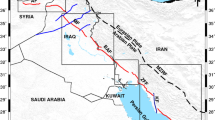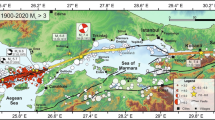Abstract
This study revealed that the East Anatolian Fault and all of its fault segments including the Dead Sea transform have emerged as the most vulnerable active faults for a large earthquake. The Anatolian Plate is sandwiched between Afro-Arabian and Eurasian plates characterized by the two major fault systems viz., the North Anatolian Fault system and the East Anatolian Fault system. Historical data revealed that the frequency of occurrence of large earthquakes (magnitude 7–8) in the North Anatolian Fault system is high, while the same in the East Anatolian Fault system is relatively less. However, the earthquake of February 6, 2023 in the East Anatolian Fault system did not occur as surprise rather lack of proper seismic study on the seismogenic character of the East Anatolian Fault system is to be blamed for the devastation caused by the earthquake. The last major earthquake occurred in 1872, not on the main East Anatolian Fault rather on the branch of the East Anatolian Fault system that connects Cyprus trench in the outer non-volcanic arc with the recurrence period of 150 years. It is observed that the fault segment connecting Cyprus trench was the triggering fault while the main East Anatolian Fault was activated through fault reactivations, new rupture and massive ground liquefaction occurred during 1268, 1872, and 2023 earthquakes causing massive devastations around Adana, Kahramanmaras, Gaziantep, and Antakya. Study of the paleo-earthquake records, tectonics, and geodynamics of the East Anatolian Fault revealed that the Dead Sea transform is likely to be the future triggering fault for transmitting seismogenic forces to all the surrounding active faults in the region. The East Anatolian Fault system including the Dead Sea transform has been evaluated as the fault where slow strain build-up for attaining saturation and release is going-on due to the southward propagation of arc-trench system and the subduction roll-back component of the eastern Mediterranean Sea block. Melts of the subduction roll-back slab is the source of the formation of pseudo-mantle plume and triple junction wherein Dead Sea transform is one of the tectonic elements of the triple junction for future seismogenic triggering agent.














Similar content being viewed by others
References
Alchalbi AM, Daoud M, Gomez F, McClusky S et al (2010) Crustal deformation in northwestern Arabia from GPS measurements in Syria: slow slip rate along the northern Dead Sea Fault. Geophys J Int 180:125–135. https://doi.org/10.1111/j.1365-246X.2009.04431.x
Ambrosino F, Thinová L, Briestenský M, Sabbarese C (2019) Anomalies identification of Earth’s rotation rate time series (2012–2017) for possible correlation with strong earthquakes occurrence. Geodesy and Geodynamics 10(6):455–459
Ansari A, Rao KS, Jain AK (2023a) Application of microzonation towards system-wide seismic risk assessment of railway network. Transp Infrastruct Geotech 1(2):3. https://doi.org/10.1007/s40515-023-00317-y
Ansari A, Rao KS, Jain AK (2023b) Seismic vulnerability of tunnels in Jammu and Kashmir for post seismic functionality. Geotech Geol Eng 41:1371–1396. https://doi.org/10.1007/s10706-022-02341-0
Carr MJ, Stoiber RE, Drake CL (1973) Discontinuities in the deep seismic zones under the Japanese arcs. Geol Soc America Bull 84:2917–2930
Condie KC (1982) Plate tectonics and crustal evolution. Pergamon Press Inc., p 310
Cramer CH, Wheeler RL (2001) The 2001 Gujarat, India earthquake and seismic hazard in Central and Eastern North America. American Geophysical Union, Spring Meeting 2001
Dilek Y, Moores EM (1990) Regional tectonics of the Eastern Mediterranean ophiolites. In: Malpas J, Moore EM, Panayiotou A, Xenophontos C (eds) Ophiolites, oceanic crustal analogues; proceedings of the symposium “Troodos 1987”. Nicosia, Cyprus, Geological Survey Department, p 295–309
Dilek Y, Eddy CA (1992) The Troodos (Cyprus) and Kizildag (S Turkey) ophiolites as structural models for slow-spreading ridge segments. J Geol 100:305–322
Görür N, Oktay FY, Seymen İ, Şengör AMC (1984) Palaeotectonic evolution of the Tuzgölü basin complex, central Turkey: Sedimentary record of a Neotethyan closure. In: Dixon JE, Robertson AHF (eds) The geological evolution of the eastern mediterranean: geological society, vol 17. Special Publication, London, pp 467–482
Güvercin SE, Karabulut H, Konca AÖ, Doğan U, Ergintav S (2022) Active seismotectonics of the East Anatolian Fault. Geophys J Int 230(1):50–69. https://doi.org/10.1093/gji/ggac045
Karakhanian A, Jrbashyan R, Trifonov V, Philip H, Arakelian S, Avagyan A, Baghdassaryan H, Davtian V, Ghoukassyan Y (2003) Volcanic hazards in the region of the Armenian nuclear power plant. J Volcanol Geotherm Res 126:31–62. https://doi.org/10.1016/S0377-0273(03)00115-X
Karataş A, Boulton SJ (2019) Morphometric characteristics of alluvial fans in Southern Turkey: implications for fault activity in the Anatolia, Arabia, Africa Triple Junction Region. Acad J Environ Sci 7(3):009–029
Khan AA (2016) Geophysical characterization and earthquake hazard vulnerability of Dhaka Mega City, Bangladesh, vis-à-vis impact of scenario earthquakes. Nat Hazards 82:1147–1166. https://doi.org/10.1007/s11069-016-2237-9
Khan AA (2023) Dual triple junction and the role of geodynamics in the event of Red Sea opening. 5th International Conference and Exhibition for Science 2023 (ICES-23-P359) Riyadh, Saudi Arabia February 6‐8, 2023. Springer Abstract Book, p 116. https://www.ices-ksa.org/index.php?p=special-issue
Kumar S (1998) Intraplate seismicity and geotectonics near the focal area of the Latur earthquake (Maharashtra). India J Geodynamics 25(1):109–128. https://doi.org/10.1016/S0264-3707(97)00016-1
Mohamed EK, Hassoup A, AbouElenean KM, Othman AA, Hamed DEM (2015) Earthquakes focal mechanism and stress field pattern in the northeastern part of Egypt. NRIAG J Astron Geophys 4:205–221
Okay Aİ, Tüysüz O (1999) Tethyan sutures of northern Turkey. In: Durand B, Jolivet L, Horvath F, Seranne M (eds) The Mediterranean Basins: tertiary extensions within the Alpine orogen: Geological Society, vol 156. London, Special Publication, pp 474–515
Rao CN, Purnachandra Rao N, Rastogi BK (2013) Evidence for right-lateral strike-slip environment in the Kutch basin of northwestern India from moment tensor inversion studies. J Asian Earth Sciences 64:158–167
Reches Z, Hoexter DF (1981) Holocene seismic and tectonic activity in the Dead Sea area. Tectonophysics 80:235–254
Sarıfakıoğlu E, Dilek Y, Sevin M (2017) New synthesis of the Izmir-Ankara-Erzincan suture zone and the Ankara mélange in northern Anatolia based on new geochemical and geochronological constraints, in Sorkhabi, R., ed., Tectonic evolution, collision, and seismicity of Southwest Asia: in honor of Manuel Berberian’s forty-five years of research contributions: Geological Society of America Special Paper 525, p. 1–XXX, https://doi.org/10.1130/2017.2525(19). © 2017 The Geological Society of America.
Srirama Rao SV, Chary KB, Gowd TN et al (1999) Tectonic stress field in the epicentral zone of the Latur earthquake of 1993. Proc Indian Acad Sci (earth Planet Sci) 108:93–98. https://doi.org/10.1007/BF02840487
Acknowledgements
There is no formal acknowledgement for this article because the entire academic and financial supports are the sole responsibility of the author. The author thankfully acknowledges Ashraful Moontahab, Research Assistant, for preparing digital elevation map of the orogenic belt of the study area for this article.
Author information
Authors and Affiliations
Corresponding author
Ethics declarations
Conflict of interest
The author declares no competing interests.
Additional information
Responsible Editor: Longjun Dong
Rights and permissions
Springer Nature or its licensor (e.g. a society or other partner) holds exclusive rights to this article under a publishing agreement with the author(s) or other rightsholder(s); author self-archiving of the accepted manuscript version of this article is solely governed by the terms of such publishing agreement and applicable law.
About this article
Cite this article
Khan, A.A. Earthquake geology of the East Anatolian Fault and its participation in a devastating earthquake. Arab J Geosci 17, 48 (2024). https://doi.org/10.1007/s12517-023-11835-x
Received:
Accepted:
Published:
DOI: https://doi.org/10.1007/s12517-023-11835-x




